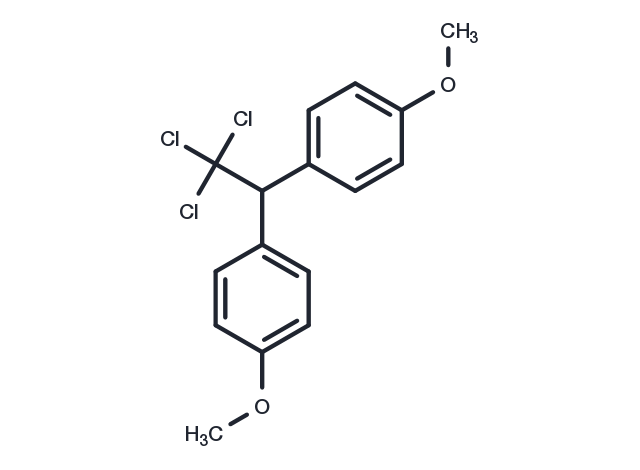Powder: -20°C for 3 years | In solvent: -80°C for 1 year
Methoxychlor 是一种有机氯农药,被认为是一种内分泌干扰物,会影响不同细胞模型中的 Ca²⁺ 稳态和细胞活力。

| 规格 | 价格/CNY | 货期 | 数量 | |
|---|---|---|---|---|
| 5 mg | ¥ 265 | 现货 | ||
| 10 mg | ¥ 372 | 现货 | ||
| 25 mg | ¥ 668 | 现货 | ||
| 50 mg | ¥ 969 | 现货 | ||
| 100 mg | ¥ 1,450 | 现货 | ||
| 200 mg | ¥ 2,180 | 现货 | ||
| 500 mg | ¥ 3,690 | 现货 | ||
| 1 mL * 10 mM (in DMSO) | ¥ 252 | 现货 | ||
| 产品描述 | Methoxychlor, an organochlorine pesticide, is thought to be an endocrine disrupter that affects Ca2 homeostasis and cell viability in different cell models. |
| 体外活性 | In HA59T cells, methoxychlor induced a [Ca2?]i rise by inducing Ca2? entry via protein kinase C-sensitive Ca2?-permeable channels, without causing Ca2? release from stores. Methoxychlor also induced apoptosis that was independent of [Ca2?]i rises. |
| 细胞实验 | Fura-2, a Ca2?-sensitive fluorescent dye, was applied to measure [Ca2?]i. Methoxychlor at concentrations of 0.1-1 μM caused a [Ca2?]i rise in a concentration-dependent manner. Removal of external Ca2? abolished methoxychlor's effect. Methoxychlor-induced Ca2? influx was confirmed by Mn2?-induced quench of fura-2 fluorescence. Methoxychlor-induced Ca2? entry was inhibited by nifedipine, econazole, SK&F96365, and protein kinase C modulators. Methoxychlor killed cells at concentrations of 10-130 μM in a concentration-dependent fashion. Chelation of cytosolic Ca2? with 1,2-bis(2-aminophenoxy) ethane-N,N,N',N'-tetraacetic acid/AM (BAPTA/AM) did not prevent methoxychlor's cytotoxicity. Methoxychlor (10 and 50 μM) induced apoptosis concentration-dependently as determined by using Annexin V/propidium iodide staining |
| 分子量 | 345.65 |
| 分子式 | C16H15Cl3O2 |
| CAS No. | 72-43-5 |
Powder: -20°C for 3 years | In solvent: -80°C for 1 year
DMSO: 22.5 mg/mL (65.1 mM)
| 可选溶剂 | 浓度 体积 质量 | 1 mg | 5 mg | 10 mg | 25 mg |
| DMSO | 1 mM | 2.8931 mL | 14.4655 mL | 28.931 mL | 72.3275 mL |
| 5 mM | 0.5786 mL | 2.8931 mL | 5.7862 mL | 14.4655 mL | |
| 10 mM | 0.2893 mL | 1.4465 mL | 2.8931 mL | 7.2327 mL | |
| 20 mM | 0.1447 mL | 0.7233 mL | 1.4465 mL | 3.6164 mL | |
| 50 mM | 0.0579 mL | 0.2893 mL | 0.5786 mL | 1.4465 mL |
对于不同动物的给药剂量换算,您也可以参考 更多...
请在以下方框中输入您的动物实验信息后点击计算,可以得到母液配置方法和体内配方的制备方法: 比如您的给药剂量是10 mg/kg,每只动物体重20 g,给药体积100 μL,一共给药动物10 只,您使用的配方为5% DMSO+30% PEG300+5% Tween 80+60% ddH2O。那么您的工作液浓度为2 mg/mL。
母液配置方法:2 mg 药物溶于 50 μL DMSO (母液浓度为 40 mg/mL), 如您需要配置的浓度超过该产品的溶解度,请先与我们联系。
体内配方的制备方法:取 50 μL DMSO 主液,加入 300 μL PEG300, 混匀澄清,再加 50 μL Tween 80,混匀澄清,再加 600 μL ddH2O, 混匀澄清。
您可能有的问题的答案可以在抑制剂处理说明中找到,包括如何准备库存溶液,如何存储产品,以及基于细胞的分析和动物实验需要特别注意的问题。
Methoxychlor 72-43-5 Others Inhibitor inhibitor inhibit
